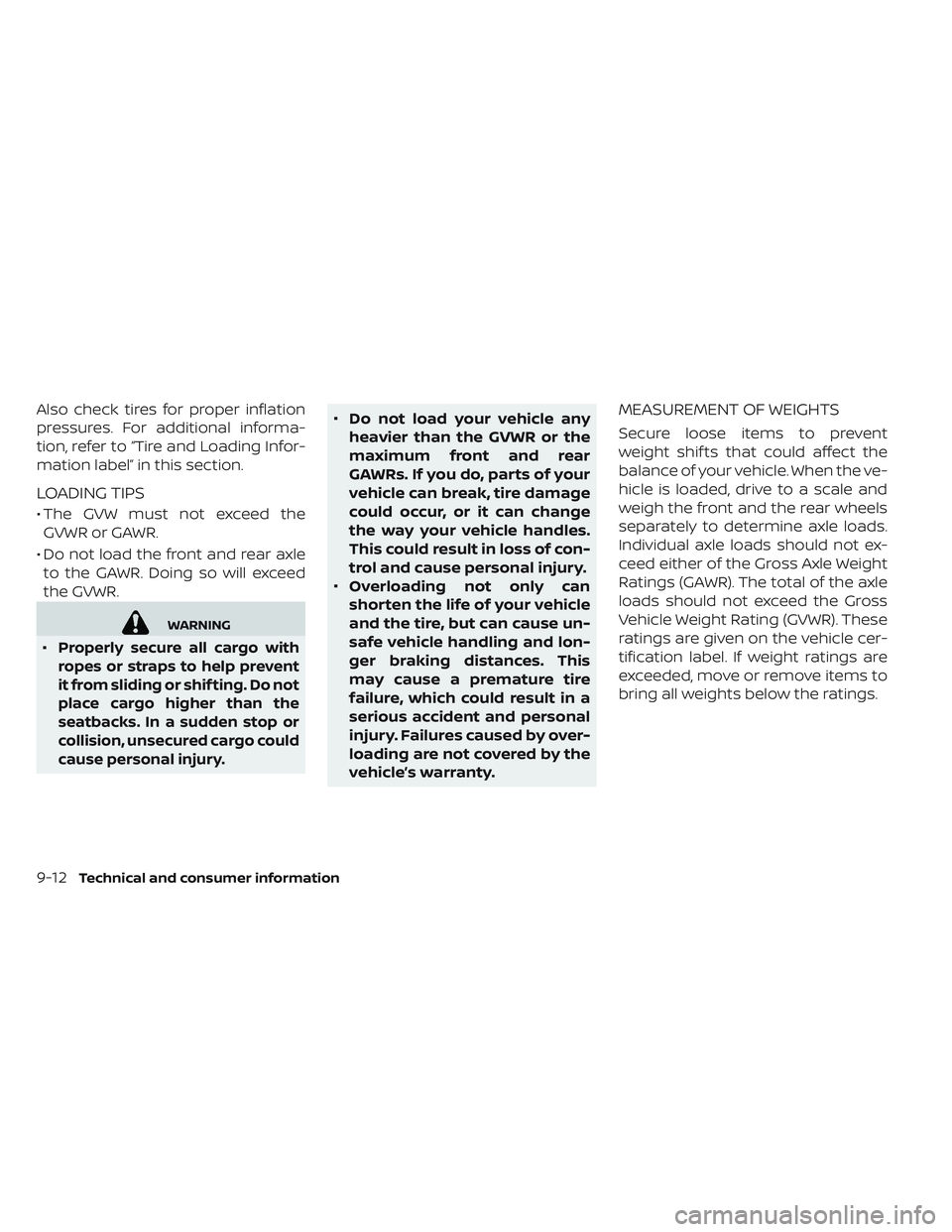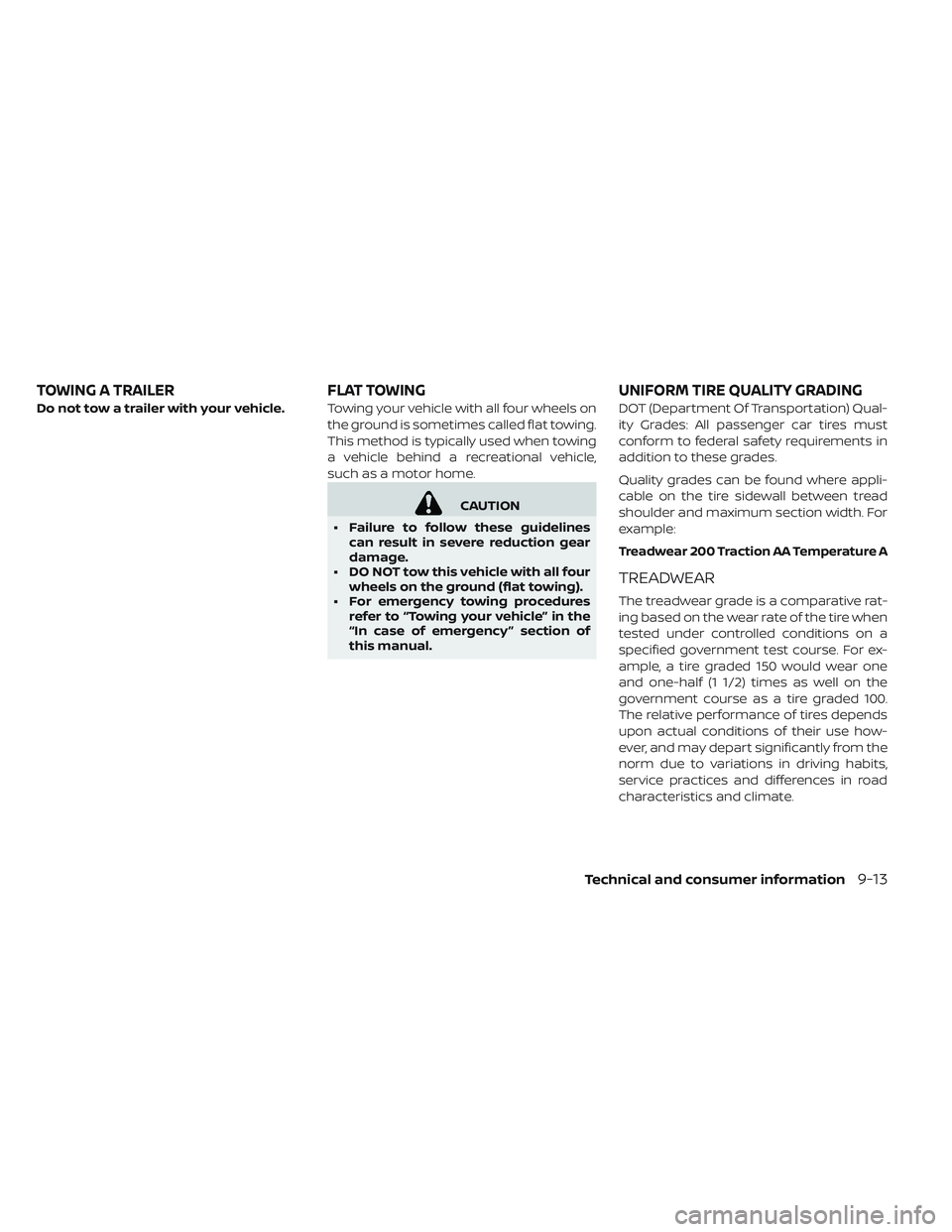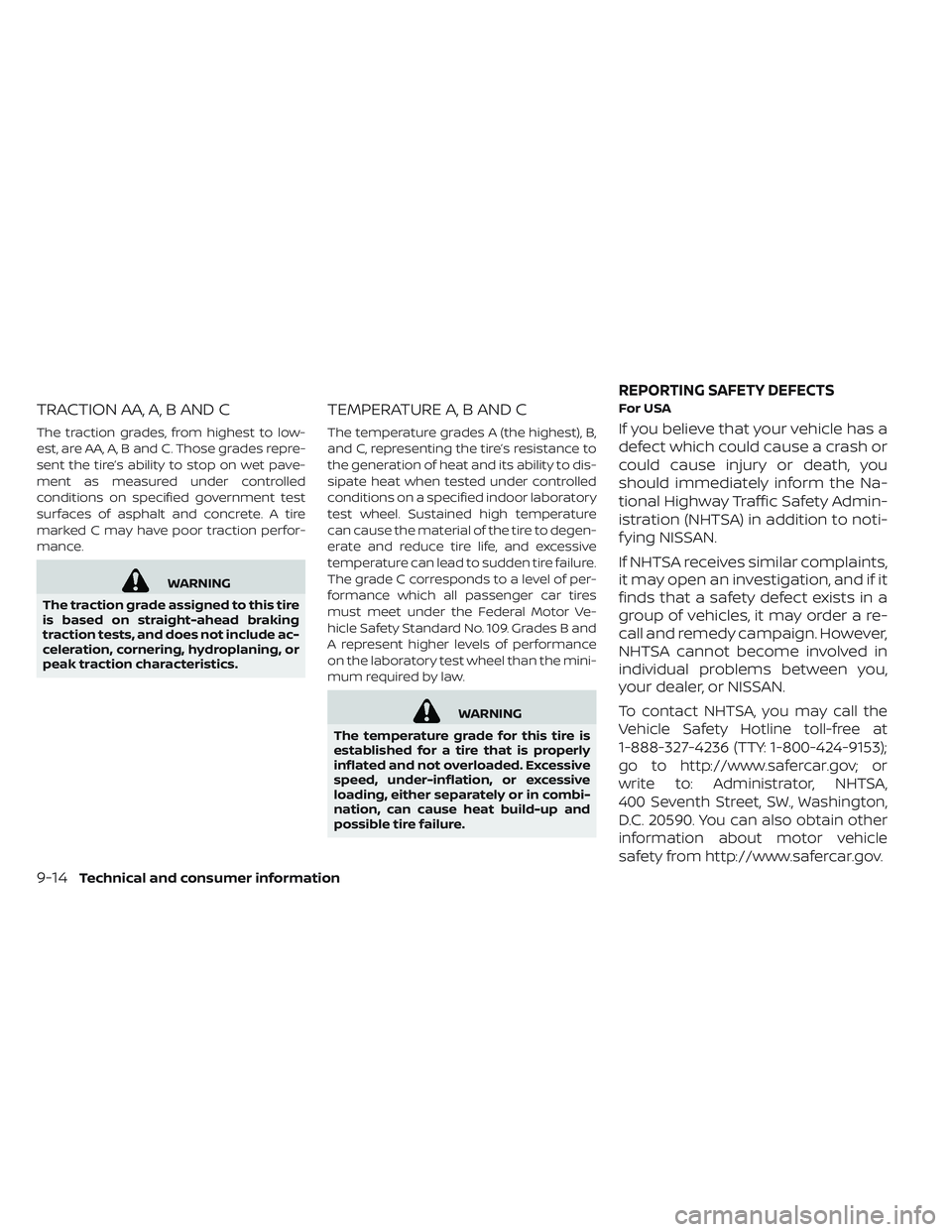2019 NISSAN LEAF flat tire
[x] Cancel search: flat tirePage 577 of 610

CHANGING WHEELS AND TIRES
Tire rotation
NISSAN recommends rotating the
tires every 5,000 miles (8,000 km).
As soon as possible, tighten the
wheel nuts to the specified torque
using a torque wrench.Wheel nut tightening torque:83 f t-lb (113 N·m) The wheel nuts must be kept tight-
ened to the specification at all
times. It is recommended that
wheel nuts be tightened to the
specification at each tire rotation
interval.
WARNING
•
Af ter rotating the tires, check
and adjust the tire pressure.
•Retighten the wheel nuts when
the vehicle has been driven for
600 miles (1,000 km) (also in
cases of a flat tire, etc.).
•For additional information re-
garding tires, refer to “Impor-
tant Tire Safety Information”
(US) or “Tire Safety Informa-
tion” (Canada) in the Warranty
Information Booklet.
Tire wear and damage
1.Wear indicator
2.Wear indicator location mark
WARNING
•
Tires should be periodically in-
spected for wear, cracking,
bulging or objects caught in
the tread. If excessive wear,
cracks, bulging or deep cuts
are found, the tire(s) should be
replaced.
8-38
Maintenance and do-it yourself
Page 579 of 610

• The TPMS sensor may be damaged ifit is not handled correctly. Be careful
when handling the TPMS sensor.
• When replacing the TPMS sensor, the ID registration may be required.
It is recommended that you visit a
NISSAN certified LEAF dealer for ID
registration.
• Do not use a valve stem cap that is not specified by NISSAN. The valve
stem cap may become stuck.
• Be sure that the valve stem caps are correctly fitted. Otherwise the valve
may be clogged up with dirt and
cause a malfunction or loss of pres-
sure.
• Do not install a damaged or de- formed wheel or tire even if it has
been repaired. Such wheels or tires
could have structural damage and
could fail without warning.
• The use of retread tire is not recom- mended.
• For additional information regard- ing tires, refer to “Important Tire
Safety Information” (US) or “Tire
Safety Information” (Canada) in the
Warranty Information Booklet.Wheel balance
Unbalanced wheels may affect vehicle
handling and tire life. Even with regular use,
wheels can get out of balance. Therefore,
they should be balanced as required.
Wheel balance service should be per-
formed with the wheels off the vehicle.
Spin balancing the wheels on the vehicle
could lead to mechanical damage.
For additional information regarding tires,
refer to “Important Tire Safety Information”
(US) or “Tire Safety Information” (Canada) in
the Warranty Information Booklet.
Care of wheels
For additional information on care of wheels,
refer to “Cleaning exterior” in the “Appear-
ance and care” section of this manual.
EMERGENCY TIRE PUNCTURE
REPAIR KIT
The emergency tire puncture repair kit
(Emergency Tire Sealant) is supplied with
the vehicle instead of a spare tire. It can be
used to temporarily repair minor tire punc-
tures. If possible, have the vehicle towed to a fa-
cility that can repair or replace the flat tire.
Using the emergency tire puncture repair
kit may cause a malfunction of the tire
pressure sensor and cause the low tire
pressure warning light to illuminate.
For additional information, refer to “Flat tire”
in the “In case of emergency” section of this
manual.
8-40Maintenance and do-it yourself
Page 580 of 610

9 Technical and consumer information
Recommended fluids/lubricants and
capacities.......................... .9-2
Air conditioning system refrigerant and
lubricant recommendations ............9-3
Specifications ........................9-4
Charging system ................... .9-4
Motor .......................... .9-5
Wheels and tires ................... .9-5
Dimensions and weights ...............9-6
When traveling or registering in another
country ........................... .9-7
Vehicle identification ................... .9-7
Vehicle Identification Number (VIN) plate . . . .9-7
Vehicle identification number
(chassis number) ................... .9-7
Traction motor serial number ...........9-8
F.M.V.S.S./C.M.V.S.S Certification label .......9-8
Emission control information label ........9-8
Tire and Loading Information label ........9-9
Air conditioner specification label .........9-9
Installing front license plate ...............9-9
Vehicle loading information ..............9-10 Terms
.......................... .9-10
Vehicle load capacity ................ .9-10
Loading tips .......................9-12
Measurement of weights ..............9-12
Towing a trailer .......................9-13
Flat towing .........................9-13
Uniform tire quality grading ..............9-13
Treadwear........................9-13
Traction AA, A, B and C ................9-14
Temperature A, B and C ...............9-14
Reporting safety defects ................9-14
Telematics overview (models with Navigation
System) .......................... .9-15
Telematic Control Unit Gen2K .............9-17
Event Data Recorders (EDR) ..............9-19
Additional Data Recording (on vehicles
equipped with optional ProPILOT Assist) . . . .9-20
Owner's Manual/Service Manual order
information .........................9-20
Char ging
information ................. .9-21
Cold tire pressures ................... .9-23
Page 591 of 610

Also check tires for proper inflation
pressures. For additional informa-
tion, refer to “Tire and Loading Infor-
mation label” in this section.
LOADING TIPS
• The GVW must not exceed theGVWR or GAWR.
• Do not load the front and rear axle to the GAWR. Doing so will exceed
the GVWR.
WARNING
•
Properly secure all cargo with
ropes or straps to help prevent
it from sliding or shif ting. Do not
place cargo higher than the
seatbacks. In a sudden stop or
collision, unsecured cargo could
cause personal injury.
•Do not load your vehicle any
heavier than the GVWR or the
maximum front and rear
GAWRs. If you do, parts of your
vehicle can break, tire damage
could occur, or it can change
the way your vehicle handles.
This could result in loss of con-
trol and cause personal injury.
•Overloading not only can
shorten the life of your vehicle
and the tire, but can cause un-
safe vehicle handling and lon-
ger braking distances. This
may cause a premature tire
failure, which could result in a
serious accident and personal
injury. Failures caused by over-
loading are not covered by the
vehicle’s warranty.
MEASUREMENT OF WEIGHTS
Secure loose items to prevent
weight shif ts that could affect the
balance of your vehicle. When the ve-
hicle is loaded, drive to a scale and
weigh the front and the rear wheels
separately to determine axle loads.
Individual axle loads should not ex-
ceed either of the Gross Axle Weight
Ratings (GAWR). The total of the axle
loads should not exceed the Gross
Vehicle Weight Rating (GVWR). These
ratings are given on the vehicle cer-
tification label. If weight ratings are
exceeded, move or remove items to
bring all weights below the ratings.
9-12
Technical and consumer information
Page 592 of 610

Do not tow a trailer with your vehicle.Towing your vehicle with all four wheels on
the ground is sometimes called flat towing.
This method is typically used when towing
a vehicle behind a recreational vehicle,
such as a motor home.
CAUTION
• Failure to follow these guidelines can result in severe reduction gear
damage.
• DO NOT tow this vehicle with all four wheels on the ground (flat towing).
• For emergency towing procedures refer to “Towing your vehicle” in the
“In case of emergency ” section of
this manual. DOT (Department Of Transportation) Qual-
ity Grades: All passenger car tires must
conform to federal safety requirements in
addition to these grades.
Quality grades can be found where appli-
cable on the tire sidewall between tread
shoulder and maximum section width. For
example:
Treadwear 200 Traction AA Temperature A
TREADWEAR
The treadwear grade is a comparative rat-
ing based on the wear rate of the tire when
tested under controlled conditions on a
specified government test course. For ex-
ample, a tire graded 150 would wear one
and one-half (1 1/2) times as well on the
government course as a tire graded 100.
The relative performance of tires depends
upon actual conditions of their use how-
ever, and may depart significantly from the
norm due to variations in driving habits,
service practices and differences in road
characteristics and climate.
TOWING A TRAILER
FLAT TOWINGUNIFORM TIRE QUALITY GRADING
Technical and consumer information9-13
Page 593 of 610

TRACTION AA, A, B AND C
The traction grades, from highest to low-
est, are AA, A, B and C. Those grades repre-
sent the tire’s ability to stop on wet pave-
ment as measured under controlled
conditions on specified government test
surfaces of asphalt and concrete. A tire
marked C may have poor traction perfor-
mance.
WARNING
The traction grade assigned to this tire
is based on straight-ahead braking
traction tests, and does not include ac-
celeration, cornering, hydroplaning, or
peak traction characteristics.
TEMPERATURE A, B AND C
The temperature grades A (the highest), B,
and C, representing the tire’s resistance to
the generation of heat and its ability to dis-
sipate heat when tested under controlled
conditions on a specified indoor laboratory
test wheel. Sustained high temperature
can cause the material of the tire to degen-
erate and reduce tire life, and excessive
temperature can lead to sudden tire failure.
The grade C corresponds to a level of per-
formance which all passenger car tires
must meet under the Federal Motor Ve-
hicle Safety Standard No. 109. Grades B and
A represent higher levels of performance
on the laboratory test wheel than the mini-
mum required by law.
WARNING
The temperature grade for this tire is
established for a tire that is properly
inflated and not overloaded. Excessive
speed, under-inflation, or excessive
loading, either separately or in combi-
nation, can cause heat build-up and
possible tire failure. For USA
If you believe that your vehicle has a
defect which could cause a crash or
could cause injury or death, you
should immediately inform the Na-
tional Highway Traffic Safety Admin-
istration (NHTSA) in addition to noti-
f ying NISSAN.
If NHTSA receives similar complaints,
it may open an investigation, and if it
finds that a safety defect exists in a
group of vehicles, it may order a re-
call and remedy campaign. However,
NHTSA cannot become involved in
individual problems between you,
your dealer, or NISSAN.
To contact NHTSA, you may call the
Vehicle Safety Hotline toll-free at
1-888-327-4236 (TTY: 1-800-424-9153);
go to http://www.safercar.gov; or
write to: Administrator, NHTSA,
400 Seventh Street, SW., Washington,
D.C. 20590. You can also obtain other
information about motor vehicle
safety from http://www.safercar.gov.
REPORTING SAFETY DEFECTS
9-14Technical and consumer information
Page 605 of 610

Charging troubleshooting guide.....CH-57
Chassis control ................5-152
Checking ..................2-17, 8-9
Checking bulbs .................2-17
Checking coolant level .............8-9
Child restraints ...........1-21, 1-25, 1-39
Child safety ....................1-18
Child safety rear door lock ...........3-6
Child seat belts .................1-18
Circuit breaker, Fusible link ..........8-20
Cleaning ......................7-3
Cleaning aluminum alloy wheels .......7-3
Cleaning exterior and interior .......7-2,7-4
Climate control .................4-46
Climate control operation ...........4-31
Climate control service ............4-46
Climate control system ............4-31
Climate control system refrigerant and
lubricant recommendations .........4-46
Climate Ctrl. Timer ...............4-41
Clock .......................2-13
Clock setting (models without Navigation
System) .....................4-56
Cold tire pressures ...............9-23
Cold weather driving .............5-154
Console box ...................2-67
coolant ......................8-8
Coolant ....................8-9, 9-2
Cooling system .................8-8
Corrosion protection ..............7-7
Cruise control ..................5-54 Cup holders
...................2-68
D
Defroster switch, Rear window and outside
mirror defroster switch ............2-53
Dimensions and weights ............9-6
Display, vehicle information .........2-28
Door locks ..................3-4, 3-6
Doors .......................3-4
Driving ................5-4, 5-15, 5-154
Driving range ..................2-10
Driving the vehicle ..............EV-18
Driving vehicle ..................5-15
E
e-Pedal......................2-14
e-Pedal system .................5-22
ECO........................2-60
ECO drive report ................5-143
ECO mode ....................2-14
ECO Mode ...................5-142
ECO switch ...................2-60
Efficient use of your vehicle ........EV-23
Electric shif t control system .........5-15
Electronic parking brake ...........5-20
Emergency charge .....CH-11, CH-17, CH-25
Emergency EV (Electric Vehicle)
shut off ...................5-12, 6-3 Emergency shutoff system
.........EV-10
Emission control information label ......9-8
EV Characteristics ..............EV-11
EV system ....................EV-2
EV unique information ............EV-25
Event Data Recorder (EDR) ..........9-19
EVSE (Electric Vehicle Supply Equipment) ....
CH-11, CH-17, CH-25
Exterior appearance care ...........7-2
F
F.M.V.S.S./C.M.V.S.S. certification label .....9-8
Flashers (Refer to hazard warning flasher
switch) .......................6-2
Flat tire ......................6-3
Flat towing ....................9-13
Floor mat cleaning ...............7-5
Fluid ................8-8, 8-10, 8-11, 9-2
FM/AM/SAT Radio with Compact Disc (CD)
Player.......................4-55
Fog light bulb replacement .........8-26
Fog light switch .................2-59
Fog lights ....................8-26
For Intelligent Key system ...........3-6
Front passenger air bag and status light. . .1-52
Front-seat mounted side-impact
supplemental air bag system ........1-58
Fuses .......................8-18
Fusible links ...................8-20
10-2Index
Page 608 of 610

Rear window and outside mirror defroster
switch......................2-53
Rear window wiper and washer switch . .2-52
Rear window wiper and washer switch . .2-52
Rear window wiper blade ...........8-17
RearView Monitor ................4-4
Recommended fluids/lubricants and
capacities .....................9-2
Reduction gear fluid ..............8-10
Remote charge ...............CH-50
Remote climate control ............4-44
Remote keyless entry function,
For Intelligent Key system ...........3-14
Remote keyless operation ..........3-14
Repairing flat tire.................6-4
Repairing tire ...................6-6
Replacement ..................8-25
Reporting safety defects ...........9-14
Road accident precautions .........EV-10
Roadside assistance program ........6-2
Rollover......................5-7
Roof-mounted curtain side-impact
supplemental air bag system ........1-58
S
Safety....................1-18, 9-14
Scene guide......EV-12, EV-15, EV-17, EV-18,
EV-21, EV-22
Seat belt cleaning ................7-7 Seat belt extenders
...............1-17
Seat belt hook ..................1-17
Seat belt maintenance .............1-18
Seat belt usage .................1-11
Seat belt warning light ............2-23
Seat belt(s) . . .1-11, 1-13, 1-14, 1-16, 1-17, 1-18, 1-19, 1-20, 1-60, 2-23, 7-7
Seatbelts.....................1-11
Seat belts with pretensioners ........1-60
Seat(s), Seats ................1-2, 2-60
Security system ................2-48
Security system (NISSAN Vehicle Immobilizer
System), EV system start ........2-49, 5-13
Servicing climate control ...........4-46
Shif ting ......................5-15
Shoulder belt height adjustment .......1-17
Shoulder belt height adjustment,
Forfrontseats..................1-17
Small children ..................1-19
Specifications ..................9-4
Speedometer ...................2-7
Starting .............5-4, 5-14, 6-10, 6-14
Starting your vehicle .............EV-17
Status light, Front passenger air bag . . . .1-52
Steering ..............2-62, 3-23, 5-146
Steering wheel switch for audio control . .4-66
Stopping the vehicle ..............6-5
Storage .....................2-66
Stowing golf bags ...............2-70
Sun visors ....................3-23
Supplemental air bag warning labels . . . .1-61Supplemental air bag warning light. .1-61, 2-24
Supplemental restraint system
.......1-43
Switch . . . .2-53, 2-54, 2-59, 2-60, 2-63, 3-5, 6-2
T
Telematic Control Unit Gen2K ........9-17
Telematics overview ..............9-15
Temperature ...................2-8
Tether strap child restraints .........1-25
Thef t (NISSAN Vehicle Immobilizer System),
traction motor start ...........2-49, 5-13
Three-point type ................1-14
Tilt steering column ..............3-23
Tilting steering column ............3-23
Tire........................2-21
Tire and Loading information label ......9-9
Tire and Loading Information label .....8-32
Tire chains ....................8-37
Tire dressing ...................7-4
Tire pressure ..................8-33
Tire pressure monitoring system (TPMS) . .6-3
Tire Pressure Monitoring System (TPMS) . .5-4
Tire rotation ...................8-38
Tires. . .5-4, 6-3, 7-4, 8-30, 8-32, 8-33, 8-36, 8-37, 8-38, 9-5, 9-9, 9-13
Tonneau cover .................2-69
Top........................1-25
Top tether strap .................1-25
Tow truck towing ................6-14
Index10-5